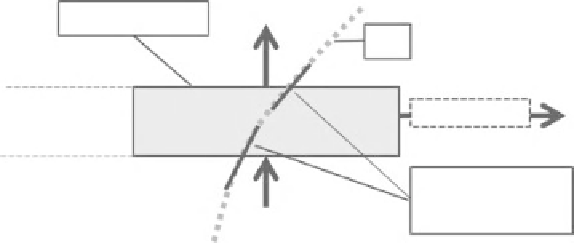Geoscience Reference
In-Depth Information
t
k
Surface area =
A
u
Figure 16.4
The flow of
momentum in the X direction
transferred by molecular
diffusion into and out of a
small volume when the
magnitude of the horizontal
velocity is changing along the
Z axis.
Acceleration
Thickness =
d
z
Different gradients
and hence different
fluxes
t
k
Consider the small element of air shown in Fig. 16.4 which has cross-
sectional area
A
and thickness
dz
and therefore has a volume
V
= (
Adz
). There
is a flow of kinematic momentum (velocity) in the X direction of
t
k
per unit
area from below the volume element that is different to the flow
t
k
′
per unit
area leaving from above. This difference will generate an acceleration of the
volume
V
in the X direction that is equal to the difference between the two
kinematic fluxes, thus:
∂
u
V
=
A
⎡
tt
′ −
⎤
(16.17)
⎣
⎦
k
k
∂
t
Because the volume element is thin,
t
k
′
can be estimated from
t
k
and the thickness
dz
by taking the first two terms in a Taylor expansion, thus:
t
tt d
∂
=+
∂
'
k
z
(16.18)
k
k
z
Substituting Equation (16.18) and
V
= (
Adz
) into Equation (16.17) gives:
⎡
⎤
∂
u
⎛
∂τ
⎞
k
(
Az
δ
)
=
A
τ
+
δ
z
− τ
(16.19)
⎢
⎥
⎜
⎟
k
k
∂
t
⎝
∂
z
⎠
⎣
⎦
and substituting Equation (16.16) into Equation (16.19) and simplifying gives:
2
∂
u
∂
=υ
u
(16.20)
2
∂
t
∂
z
The above analysis only considers the diffusion along the Z axis of velocity (i.e.
kinematic momentum) in the X direction, but analogous analyses can be made for
diffusion along the X and Y axes of kinematic momentum in the X direction.
Consequently, the total rate of change in kinematic momentum in the X direction
associated with molecular diffusion processes that must be included as a 'forcing







